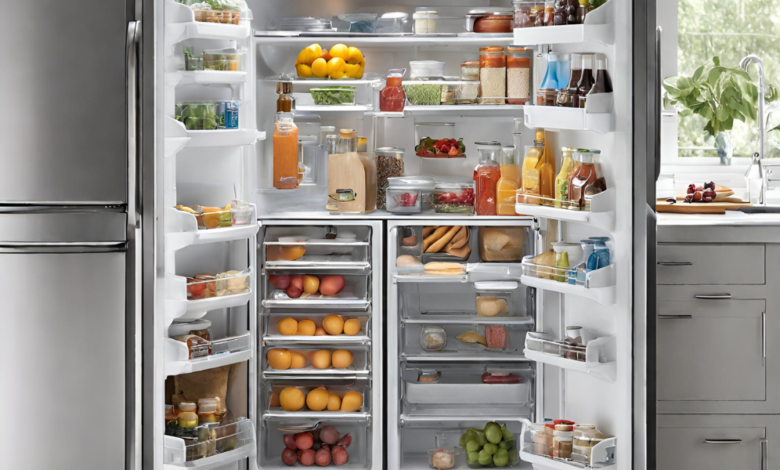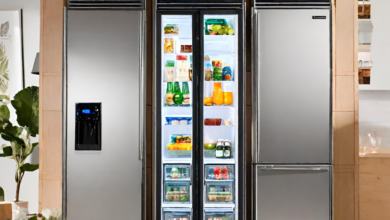Maximizing Refrigerator Space with Clever Organization: A Comprehensive Guide to Efficient Storage

A refrigerator is the heart of any kitchen, tasked with preserving the freshness of our food and beverages. However, the challenge lies in efficiently utilizing the available space to ensure that every nook and cranny is optimized for storage. In this in-depth and highly detailed blog, we will explore a variety of clever organization techniques to help you maximize your refrigerator space, keeping your food fresh and easily accessible.
1. Clear Out and Clean Up
Before diving into the organization process, it’s crucial to start with a clean slate. Remove all items from your refrigerator and assess their freshness. Discard expired items, leftovers that have seen better days, and anything that no longer serves a purpose. Once the refrigerator is empty, take the opportunity to clean shelves, drawers, and compartments thoroughly. This will provide a fresh and hygienic canvas for your organized storage.
2. Categorize and Prioritize
To optimize refrigerator space, categorize your items into groups based on their type and frequency of use. Common categories include dairy, vegetables, fruits, meats, condiments, and beverages. Prioritize items that need to be used sooner to minimize food waste and ensure that perishables are easily accessible.
3. Utilize Adjustable Shelving
Many modern refrigerators come equipped with adjustable shelving. Take advantage of this feature to create customized spaces for different-sized items. Tall items like juice bottles or pitchers can be accommodated by adjusting the height of shelves, while shorter shelves can be used for smaller items.
4. Invest in Clear Storage Containers
Clear storage containers offer a visual advantage, allowing you to see the contents without having to open each container. Opt for stackable containers to maximize vertical space and make the most of your refrigerator’s height. This not only adds a sense of order but also helps in locating items quickly.
5. Use Drawer Dividers
Refrigerator drawers often become chaotic with various fruits and vegetables jumbled together. Employ drawer dividers to create separate sections for different types of produce. This prevents cross-contamination and makes it easy to find what you need. Additionally, consider using moisture-absorbing liners to keep fruits and vegetables fresh for longer.
6. Labeling Systems
Implementing a labeling system can be a game-changer in maintaining an organized refrigerator. Label shelves, bins, and containers to designate specific zones for different categories of items. This not only streamlines the organization process but also helps other household members maintain the system.
7. Optimize Door Storage
Refrigerator doors are often underutilized, but with the right strategy, they can become valuable storage space. Use the door shelves for condiments, sauces, and small items that don’t require constant refrigeration. Be mindful of temperature fluctuations, and avoid storing highly perishable items on the door.
8. Temperature Zones
Understanding the temperature zones in your refrigerator is essential for proper food storage. The lower shelves tend to be colder, making them ideal for dairy and meats. The upper shelves are slightly warmer and are suitable for leftovers, drinks, and ready-to-eat items. Utilize the crisper drawers for fruits and vegetables, adjusting humidity settings based on the produce type.
9. Rotate and Restock Strategically
Implement a “first in, first out” approach to ensure that older items are used before newer ones. When restocking groceries, place new items behind existing ones to encourage rotation and prevent items from being forgotten or expiring.
10. Freeze Smartly
If your refrigerator has a freezer compartment, organize it with efficiency in mind. Invest in freezer baskets and bins to categorize frozen goods. Label items with the date of freezing to keep track of their freshness. Regularly declutter the freezer to make room for new items and avoid a buildup of freezer-burned or expired foods.
11. Consider Vacuum Sealing
For those who are serious about extending the shelf life of their food, vacuum sealing is a game-changing technique. Vacuum-sealed bags remove air, preventing freezer burn and maintaining the freshness of items for a longer duration. This method is particularly beneficial for meats, fruits, and vegetables.
12. Monitor and Adjust
Refrigerator organization is an ongoing process that requires regular monitoring and adjustments. As you use your refrigerator, take note of what works and what doesn’t. Be open to tweaking your organization system to better suit your needs and the needs of your household.
Conclusion
Maximizing refrigerator space is a skill that combines thoughtful organization with a strategic approach to food storage. By implementing the tips and techniques outlined in this comprehensive guide, you can transform your refrigerator into a well-organized space where freshness is preserved, and efficiency reigns supreme. Remember, a well-organized refrigerator not only enhances the quality of your food but also simplifies your daily cooking routine.






